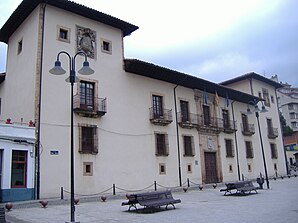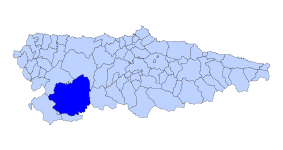Cangas del Narcea
| Cangas del Narcea municipality | ||
|---|---|---|

|
||
| coat of arms | Map of Spain | |

|
|
|
| Basic data | ||
| Autonomous Community : |
|
|
| Comarca : | Narcea | |
| Coordinates | 43 ° 11 ′ N , 6 ° 33 ′ W | |
| Height : | 396 msnm | |
| Area : | 823.57 km² | |
| Residents : | 12,347 (Jan 1, 2019) | |
| Population density : | 14.99 inhabitants / km² | |
| Postal code : | 33800-33819 | |
| Municipality number ( INE ): | 33011 | |
| Nearest airport : | Asturias Airport 81.7 km | |
| administration | ||
| Mayor : | José Luis Fontaniella Fernández ( PP ) | |
| Address of the municipal administration: | Plaza Conde Toreno, s / n - 33800 CANGAS DEL NARCEA | |
| Website : | ayto-cnarcea.es | |
| Location of the municipality | ||

|
||
Cangas del Narcea is a municipality in the autonomous region of Asturias , in northern Spain . Bounded to the north by Allande and Tineo , to the south by Degaña and Laciana in the province of León , to the west by Ibias and to the east by Somiedo .
geography
The city with 12,347 inhabitants (as of January 1, 2019) is the capital of the municipality of the same name (concejo), which is also the oldest in Asturias. With an area of 823.57 km² it is also the largest municipality in Asturias.
history
As in all of Asturias, finds already confirm a settlement during the Stone Age , but the settlement was poet in the Iron Age , and finds in neighboring Ibias confirm a lively artisanal culture which also carried out extensive trade, which is proven by ceramic and coin finds.
Much evidence has survived
from the Romanization period to the Middle Ages , as the municipality is not only the largest in Asturias, but also the oldest. The (monastery) Monasterio de San Juan Bautista in Corias was founded in 1032 , which is currently being renovated and will be reopened as a Parador in 2008 .
In 1255, under Alfonso X, the place Cangas de Sierra was named as the administrative capital of the region. In the late Middle Ages under Alfonso XI. (called the Avenger) the monastery in Corias received extensive privileges for its support.
During the Napoleonic War , many art treasures were confiscated and are probably lost forever. The destruction of the monastery rights led to the division of the area into the smaller administrative communities Espina-Ponferrada, Cangas-Ouviñano, and Puente Nuevo.
It was not until the 20th century that the town of Cangas del Tineo was renamed Cangas del Narcea and became the regional capital. Already in the 19th century there was a great wave of emigration overseas. Many Cangüeses tried their luck in the newly formed republics of South America, especially Argentina. In second place was the emigrant destination Cuba , which at that time still belonged to the Spanish Empire. In the first half of the 20th century, massive emigration to Argentina continued, and it was only after the civil war that the Cangüeses began to orient themselves towards Europe. Many fled to France for political reasons. However, economic emigration to Switzerland became particularly important in the 1960s.
geology
Waters
The rivers Narcea , Degaña and Ibias have their source here in the Natural Park Fuentes del Narcea, Degaña y Ibias.
climate
According to the coastal area, the climate is maritime and humid with pleasantly mild summers and also mild, rarely severe winters. Due to the Picos de Europa in the hinterland, fog is to be expected in spring and autumn.
fauna
Large populations of (also rare) birds of prey are a confirmation of the "healthy" nature. So here you will find, among other things: hawks , sparrow hawks , short-toed eagle , golden eagle , and some representatives of the owls and screech owls like the tawny owl and also Egyptian vultures , griffon vultures and grouse can be found here.
For nature lovers, Regien - almost like all of Asturias - is a Dorado. Because the predators can only live where they can find enough food. This means that the fauna also consists of songbirds and mammals , but not all of them are listed here.
economy
The entire region is primarily characterized by agriculture and mining. Especially the wine-growing and cattle breeding has a long tradition here, and of course, the trade has grown. The construction industry and the tourism industry have been growing at a healthy rate since people understood how to use the national park's potential.
| Employees | Percentage | ||||
|---|---|---|---|---|---|
| total | 5,023 | 100 | |||
| Agriculture, livestock and fishing | 1,031 | 20.53 | |||
| Industry | 502 | 9.99 | |||
| Construction industry | 668 | 13.30 | |||
| Service companies | 2,822 | 56.18 | |||
| * Data from the Statistical Office for Economic Development in Asturias, status 2009 (PDF; 109 kB), SADEI | |||||
Population development of the municipality

Source: INE archive - graphic processing for Wikipedia
politics
The 17 seats of the municipal council are elected every 4 years and are divided as follows:
|
|
||||||||||
| Political party | 1979 | 1983 | 1987 | 1991 | 1995 | 1999 | 2003 | 2007 | 2011 | 2015 |
|---|---|---|---|---|---|---|---|---|---|---|
| PSOE | 1 | 7th | 10 | 11 | 8th | 9 | 7th | 8th | 4th | 5 |
| CD / PP | 3 | 5 | 3 | 6th | 6th | 5 | 7th | 6th | 5 | 8th |
| PCE / IU - BA | 2 | 6th | 3 | 3 | 2 | 1 | 2 | 3 | 6th | 3 |
| UCA | 5 | |||||||||
| MC | 1 | 1 | ||||||||
| UCD / CDS | 9 | 5 | ||||||||
| PAS | 1 | 1 | ||||||||
| Conceyu | 1 | |||||||||
| URAS | 1 | 1 | ||||||||
| FAC | 2 | 1 | ||||||||
| Independientes | 2 | |||||||||
| total | 21st | 21st | 21st | 21st | 17th | 17th | 17th | 17th | 17th | 17th |
Attractions
- Dominican monastery of Corias
- Basílica Santa María Magdalena
- Palacio de Omaña - Palacio de los Condes de Toreno
- San Juan Bautista Monastery in Corias
- the surrounding area with the national park under UNESCO protection
- Palacio de Peñalba
- Capilla del Santísimo Cristo del Hospital
- Teatro Toreno
- Barrio de Entrambasaguas with Roman bridge
- Santuario del Acebo
Festivals and Celebrations
- Nuestra Señora del Carmen y la Magdalena, in Cangas, from July 16-22
- La romería de Nuestra Señora del Acebo, in la sierra de los Acebos, on September 8th
- La romería de Santarbás, June 19th
Parroquias
The parish is divided into 54 parroquias:
Individual evidence
- ↑ Cifras oficiales de población resultantes de la revisión del Padrón municipal a 1 de enero . Population statistics from the Instituto Nacional de Estadística (population update).
- ^ Ministerio del Interior
- ^ Federación Asturiana de Concejos
- ↑ 2011 Spanish Ministry of the Interior
- ↑ 2015 Spanish Ministry of the Interior ( Memento of the original from June 10, 2015 in the Internet Archive ) Info: The archive link was inserted automatically and has not yet been checked. Please check the original and archive link according to the instructions and then remove this notice.


